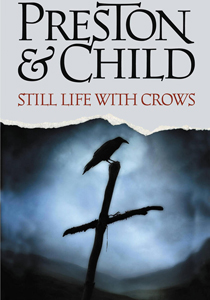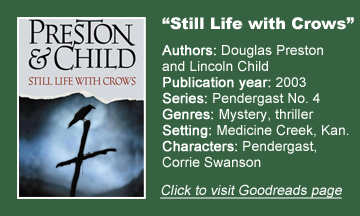“Still Life with Crows” (2003) is “merely” a standalone Agent Pendergast novel, but it features the introduction of Corrie Swanson, the evocative cornfields and caves (!) of western Kansas, a looming storm and a monster even creepier than the “Relic” beast.
It became my favorite Douglas Preston & Lincoln Child novel on my first read, and it still holds that status. In their eighth novel (and fourth starring the FBI agent), the masters click on all cylinders like Pendergast’s Rolls-Royce.
The FBI agent and the Goth girl
The vacationing agent (yes, he pursues a case in a remote corner of the USA on his “vacation”) makes teenage Goth girl Corrie a better person simply by trusting her as his assistant, and they both become more entertaining characters by playing off each other.
Pendergast does odd and amazing things here – notably dream-walking into the past to learn the details of a battle between Indians and white settlers – and I buy it because of the perspective of the cynical Corrie, who is increasingly won over.
Pendergast is weird – wearing all black in the cruel August heat and being particular about the preparation of his beef and tea — but he’s the first adult who has treated Corrie with respect. “Still Life” makes a compelling case that sometimes that’s all a troubled teen needs to get on a good path.
It might’ve been tempting for P&C to make Medicine Creek’s Sheriff Hazen into a dolt and play his investigation as a joke, but he’s actually competent, and his annoyance with Pendergast butting into his territory is understandable.
Hazen makes a logical leap pointing to a businessman in nearby Deeper as the culprit behind the string of murders with a seemingly ritualistic touch. He’s wrong, and we know it, but “Still Life” has such a bizarre answer for the murderer’s identity that we forgive Hazen for going down the wrong path.
Reads like a great horror film
Perhaps the biggest mystery of P&C’s career is why Hollywood hasn’t made all of their novels into movies, and “Still Life with Crows” in particular reads like a great horror film. The villain and the sociological explanation for his behavior are creative yet chillingly plausible, and parsed out piecemeal enough to keep us engaged till the last of the 564 pages.
Along with their winning portrayal of Corrie – who has grown into an FBI agent herself in “Old Bones” — the authors are at the top of their character-building game.
The setting is fibbed by P&C; there aren’t really caves in Kansas. But they make good use of the stultifying air of thick, near-harvest cornfields; the niceties, bullying and politics of a dying town; and Corrie’s trailer park life with her alcoholic mom before they get to the cave-set grand finale.
“Still Life” is filled with false leads and notions that nonetheless serve a purpose. Corrie’s dad ran off at some point in the past, and the authors play that close to the vest so we wonder if he was perhaps an unknown victim.

This novel is no turkey
And in his Pendergastian way, the agent treats himself (and the readers) to a tour of the local turkey plant, illustrating how turkeys get from farm to table, including a memorable mention of them shitting themselves in fear.
I don’t know if P&C are intentionally making an anti-meat-eating statement, but they succeed. Suffice it to say you won’t want to read this chapter right before sitting down for your Thanksgiving dinner. Meanwhile, it sets the book’s horror tone, even if the turkey plant isn’t the core setting.
Speaking of creepy settings, a couple of chapters check in with Wren’s progress at cataloguing Pendergast’s cabinet of curiosities back at the New York mansion, and we get further hints that a child is hiding in the underground passages.
The inclusion of this thread whets our appetite for further Pendergast adventures on his home turf. But the teaser is hardly needed, because after “Still Life with Crows,” the sheer quality of Preston & Child’s novels is enough to have readers returning for the next one.


